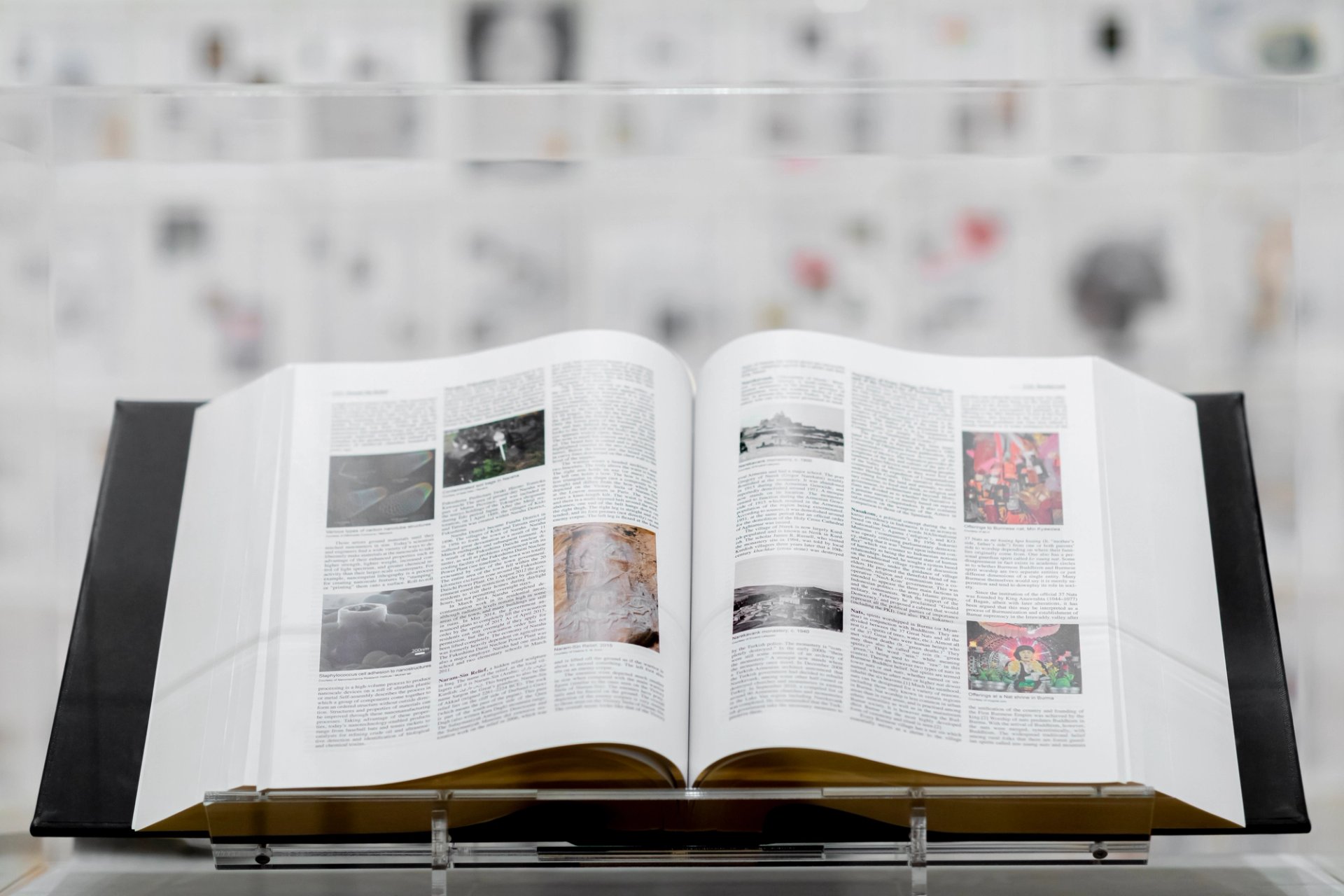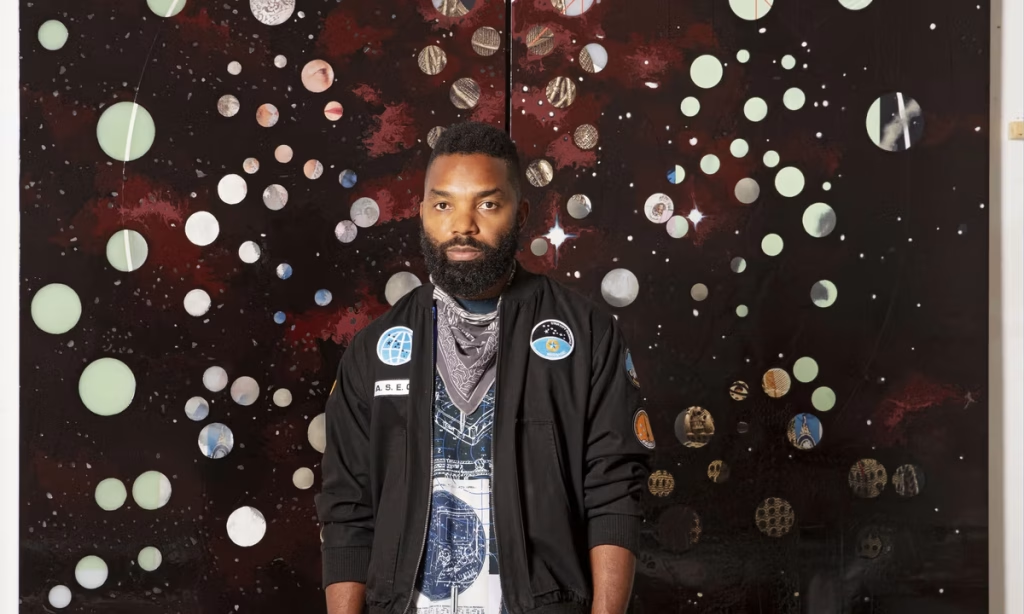Everybody remarks on how clear the Bahamian waters are—azure blue, crystalline and teeming with life. The edgless clarity of the Bahamian sky, un-crowded by the blare of light pollution, gets less attention. The artist Tavares Strachan grew up in Naussau with his head cocked star-wards, watching the glow of constellations twinkle and shift in infinite dimensions. It is little wonder, then, that he has never paid much attention to limitations. Since he arrived on the art scene after graduating from Yale University’s MFA programme in 2006, his practice has spanned countless materials, genres, themes and storytelling schema, spanning concepts as diverse as space travel and Black haircare.
His new solo exhibition at the Los Angeles County Museum of Art (Lacma), The Day Tomorrow Began (until 29 March 2026), leads viewers through a maze of multi-sensory installations, combining neon, ceramics, bronze, painting, text and performance elements in service of immersive, kaleidoscopic world-building. Co-organised with the Columbus Museum of Art in Ohio, The Day Tomorrow Began features 20 new works that excavate invisible histories, the sort of stories that don’t fit neatly inside white supremacy’s narrative of the past. (In Columbus, a new permanent installation by Strachan is being unveiled 24 October in the form of a participatory speakeasy called Bar Room; The Day Tomorrow Began opens next May.)
In a geopolitical context marked by censorship and surveillance, The Day Tomorrow Began feels like a deep, recalibrating exhale by an artist daring to dream of a less encumbered, more equitable future.
Strachan has positioned himself as an artist-explorer throughout his career, training as a cosmonaut, collaborating with Massachusetts Institute of Technology scientists and physically tracing the steps of the first person to reach the North Pole, a Black man named Matthew Henson. His theoretical collapse of the pre-Modern expedition ethos with his own creative process is on full display in Encyclopedia of Invisibility (2018), a signature undertaking that is spotlighted in the exhibition. The artist’s spin on the Encyclopedia Britannica spans more than 2,000 pages, relaying information about people, places and ideas that Strachan has deemed “invisible” to the mainstream.
A new collection of bronze sculptures, simultaneously stately and surreal, interrogate the fraught role of public monuments in constructing nationalist memory, calling upon folklore imagery and figures from the Haitian Revolution to formulate a post-colonial visual language. There is also a hypnotic neon piece both lionising and contrasting the words of two heavyweight American men of letters: James Baldwin and Mark Twain. Expansive and diverse as his chosen media may be, Strachan’s primary artistic throughline is a restrained, high-finish elegance, a straight-backed form of attention that imbues more organic elements of his tableaus with hard-won gravitas. Strachan may eschew limits, but never standards—his ceramics are impossibly smooth, his hand-rendered annotations careful and precise.
Strachan, who splits his time between Nassau and New York, has shown his work at Prospect New Orleans, the Biennale Lyon and the MIT List Visual Arts Center. He represented the Bahamas at the 55th Venice Biennale, and is a MacArthur Foundation fellowship recipient, as well as the winner of a Lacma Art + Technology Lab Artist Grant. In Nassau, he has established an art studio and scientific research platform, the Bahamas Aerospace and Sea Exploration Center, as well as Oku, a non-profit that includes an artist residency, exhibition spaces, a scholarship scheme and an after-school creative programme.
The Art Newspaper caught up with Strachan to talk about titles, process, and politics.
Tavares Strachan, Inner Elder (Nina Simone as Queen of Sheba), 2023 Courtesy the artist. Photo by Jonty Wilde
The Art Newspaper: Where did you get your inspiration for the title of the exhibition, The Day Tomorrow Began?
Tavares Strachan: We’ve grown accustomed to titles not being as important as at least I think they should be! This title is very meaningful to me because it’s about the fragility of that single second between one day and the next, what the body does and what the mind does with the uncertainty that comes with that one second when we don’t know what’s going to happen the next day. In this moment with such intense anxiety about everything going on in the world, I thought it was appropriate to focus on the potential hope in that one second between one day and the next.
Could you talk about your fascination with Henri Christophe and the Haitian Revolution, and how it reverberates in the current political moment?
There are a couple of threads there. The first one is that I discovered the story of Henry Christophe in the Haitian Revolution. Obviously, I was born in the Bahamas. My best friend is named after Henri Christophe and is related to him. We were just hanging out one day as teenagers, and he said, “Oh, my name’s after this guy.” And I was like, “Oh, OK. Interesting.” But there was no mention of Christophe in any places of higher learning, any school. So I think that’s the first thread.
The second one is that it’s impressive how something so integral to the Western world, to this region, in this hemisphere at least, is so unseen. It’s not a part of the storytelling traditions in the West, because this revolution happened before America existed.
The third thread is, in particular to this work, that one of the ironies of the story of the revolution is that Christophe named himself King, which in some ways is a very problematic position to take in relation to the causes that he was fighting for. All those layers are what the work is about.
How does this work grapple with censorship while also investing in the notion of hope?
For me, it’s not a question of “now”, it’s more a question of “always”. The interesting thing about the current moment is that it’s a very interesting window into procedure, right? The procedures of regimes that have in the past used techniques that are similar to what we’re seeing now. Having this work exist within this moment is a good measuring stick to that moment, to those moments of protest in the street.
Is there a certain methodology you use to translate specific ideas into specific media?
It’s about world-making. The idea of creating logic for an audience to experience physically in a moment when everything’s so mediated is the grounding element, right? So smell is very important. Sound is incredibly important. Pacing is important. Tempo is incredibly important. Making rooms that you can walk through quickly versus ones that you have to slow down. Making rooms that are incredibly bright, ones that are incredibly dark. The intention is to unpack a level of human emotion and presence that is really important for me to transmit to the audience. I see myself as an audience for this work also. And a lot of that desire to give an audience an experience that can unlock some sort of emotional potential is what’s driving some of the material choices.
I know you have a background in glass from your undergraduate studies at the Rhode Island School of Design. What about neon felt like a good fit for a piece about James Baldwin and Mark Twain, two giants of language?
You know, there’s something magical about trapping gas and electrifying it and letting it light up. That makes sense in terms of the context of these two poets who are really humanists, and they’re really mining this place of looking for how we’re the same versus how we’re different, which I think is what so much of the exhibition’s about. I couldn’t think of a better material other than glass and neon to tell a story.

Tavares Strachan, Six Thousand Years, 2018 Courtesy Tavares Strachan and the San Francisco Museum of Art, photo by Frazer Bradshaw
Speaking of humanism, what is your humanist interest in space exploration as an artist?
I was a kid who was always fascinated by exploration, working on boats as a child growing up. And I spent a lot of nights on the ocean mapping the stars. There’s a richness of physical and metaphysical metaphors that go along with space—the history of humans and the history of human travel and the history of storytelling. Space also feeds into this frontier idea and there’s a layer of storytelling when you think about the history of human beings, history of exploration and all the challenges and the problems that go along with it. You know, the feelings of exhilaration and adventure.
Speaking of Enlightenment-era logic, I’ve got to know how you made this encyclopaedia. How long have you been working on it?
It started with my encounter with the story of Matthew Henson. Obviously, he’s the pioneer who discovered the North Pole. The misdirection moment is the fact that he’s a Black man who is this Arctic explorer, which for a lot of people seems to be unusual, but for him was quite standard. That story forced me to think about all the other stories that may sit in the pocket of Matthew Henson’s story. When I started doing all this research, it was just me alone for the first year, and then two years later, I had one assistant and then two, and then 18 years later, we produced the book. There’s 17,000 entries in total.
- Tavares Strachan: The Day Tomorrow Began, until 29 March 2026, Los Angeles County Museum of Art
